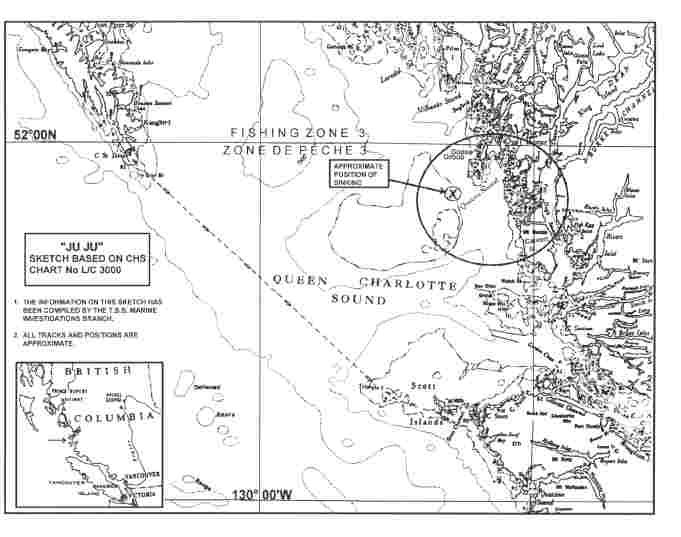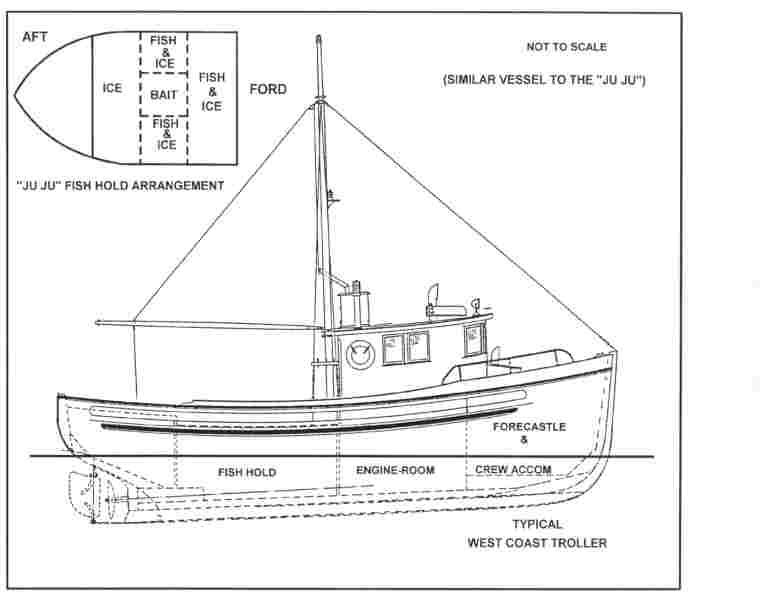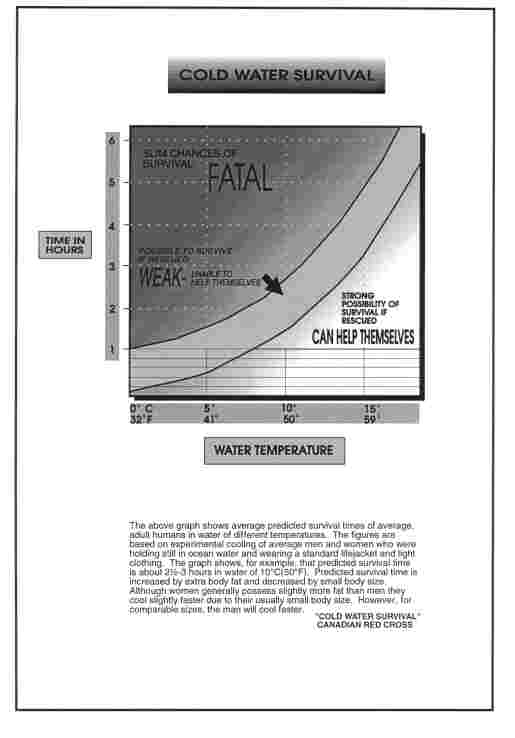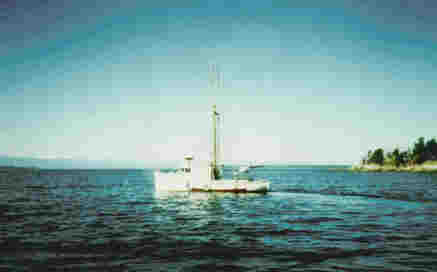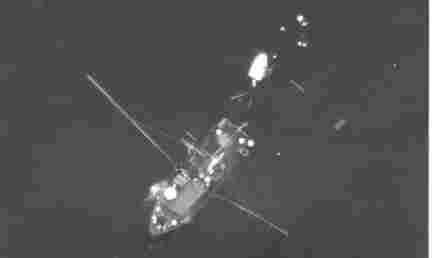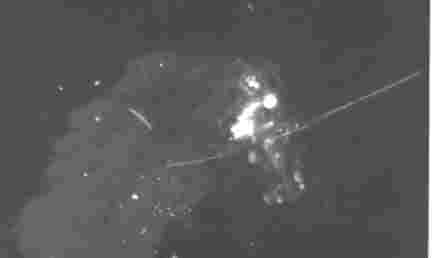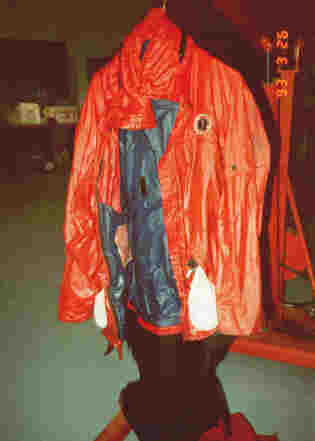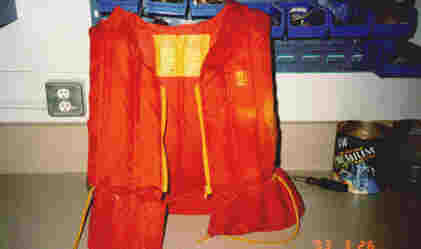Sinking of the small fishing vessel "JU JU"
Queen's Sound, British Columbia
The Transportation Safety Board of Canada (TSB) investigated this occurrence for the purpose of advancing transportation safety. It is not the function of the Board to assign fault or determine civil or criminal liability. This report is not created for use in the context of legal, disciplinary or other proceedings. See Ownership and use of content.
Summary
On 19 March 1993, the "JU JU" was proceeding to Kildidt Sound, British Columbia, to shelter from a south-easterly gale. The vessel took on water below decks and sank shortly thereafter. Two of the three crew members were rescued from the water, suffering from hypothermia. The third to be recovered had succumbed to hypothermia and drowned.
The Board determined that, while heading for shelter at full speed and pounding into the heavy seas, the "JU JU" most probably sprang a plank below the waterline. The vessel then began flooding into the after spaces, settled quickly by the stern, and subsequently downflooded and sank. Factors that contributed to the loss of life were the inadequacy of the life-saving equipment carried and the crew's inexperience and lack of formal marine and survival training.
1.0 Factual Information
1.1 Particulars of the Vessel
| "JU JU" | |
| Official Number | 173778 |
| Port of Registry | Victoria, B.C. Footnote 1 |
| Flag | Canadian |
| Type | Longliner |
| Gross Tons Footnote 2 | 9 |
| Length | 10.59 m |
| Breadth | 2.87 m |
| Built | 1938, Victoria, B.C. |
| Propulsion | Chrysler Nissan Model SD33, developing 80 BHP |
| Owner | Ian Andrews Dawson Creek, B.C. |
1.1.1 Description of the Vessel
The "JU JU", a small wooden fishing vessel with a traditional double-ended troller hull, was of closed construction. The cabin was forward of amidships, the engine-room was directly below the cabin, and the fish hold was immediately aft of the cabin. The lazaret space and cockpit were abaft the fish hold. Rigging included an aluminium mast, trolling poles and stabilizer poles. The aluminium longline drum was on the port side.
1 See Glossary for all abbreviations, acronyms, and definitions.
2 Units of measurement in this report conform to International Maritime Organization (IMO) standards or, where there is no such standard, are expressed in the International System (SI) of units.
1.2 History of the Voyage
On the morning of 19 March 1993, the "JU JU" departed from her anchorage east of Goose Island, B.C. The vessel proceeded to a position 1.5 nautical miles (M) south-west of Currie Lighthouse, Queen's Sound, B.C., where a longline set the previous day to catch ling cod was recovered. The sea was choppy at the outset, and there was little wind. The "JU JU" had been fishing in the area for two days, sheltering at night.
As the longline was being taken on board, the wind rose from the south-east at 15 to 25 knots (kn). With the line on board, the deck was secured and the hatch cover put in place on the fish hold. A course was set at full speed for Kildidt Sound, some 16 miles in an east-south- easterly direction, to shelter from impending south-easterly gales. The vessel's paravane stabilizers were deployed at all times.
Shortly after leaving the fishing grounds, as the vessel proceeded, at times pounding into the seas, the owner/operator found that the "JU JU" was becoming difficult to steer and had assumed a large trim by the stern.
The vessel was slowed to an idle and hove-to into the wind so that the situation could be assessed. The engine-room was found to be dry. However, the fish hold, lazaret space, and cockpit pumps were in full operation, as evidenced by the discharge lines on deck. It soon became necessary to bail out the cockpit with buckets as the stern sank deeper and seas were shipped on deck over the starboard side.
The owner/operator sent a distress (MAYDAY) message to Alert Bay Coast Guard Radio Station (CGRS) by very high frequency radiotelephone (VHF R/T) at 1000Footnote 3. The dinghy was launched on the starboard side.
Shortly after the distress message was sent, water was seen to enter the engine-room bilge by way of the propeller shaft space. The engine-room pumps were started immediately, but they could not cope with the ingress of water. Water had also entered the forecastle accommodation. The vessel then listed slightly to port, and the engine stalled, causing the "JU JU" to lose steerage and to fall into the trough of the waves. With the stern settling still deeper, water entered the cabin door and downflooded into the forward spaces.
All three crew members abandoned ship into the dinghy, which capsized, throwing them into the water. Two of the crew members climbed back on board the sinking vessel. The owner/operator held on to the dinghy, which was inadvertently cast off. The two crew members climbed the mast as the vessel sank in the hope that it would remain afloat in a waterlogged condition. The "JU JU" sank soon after, at about 1048, forcing the crew members into the water. The vessel sank in 146 m of water in approximate position 51°48′N, 128°24′W.
3 All times are PST (Coordinated Universal Time (UTC) minus eight hours) unless otherwise stated.
The weather at the time was clear. Seas were to 2.2 m, and the wind was from the south- east at 25 kn.
1.3 Search and Rescue
Rescue Co-ordination Centre (RCC) Victoria tasked sea and air resources to proceed to the scene. An Aurora R105 aircraft that was on a training exercise from Canadian Forces Base (CFB) Comox was close by and was designated On-scene Commander. The aircraft made visual contact with the "JU JU" at 1009 and directed rescue vessels to the area by dropping smoke flares. As it was on a training flight, the aircraft was not equipped with SKAD packs (see Glossary at Appendix E).
At 1132, a Buffalo aircraft from Rescue 442 Squadron of CFB Comox dropped SKAD packs with two liferafts close to the people in the water; however, they were hypothermic and incoherent and did not see the rafts. The small fish packer "LIL CHRISTINE" was the first vessel on scene. This vessel's crew rescued the owner/operator and one of the deck-hands at 1139. At 1247, the Fishery Patrol Vessel "TANU" recovered the body of the second deck-hand 1.8 M north-west of the position in which the "JU JU" sank.
1.4 Injuries to Persons
The two surviving crew members were transported by helicopter to Port Hardy Hospital, where they were kept overnight and treated for hypothermia. The deceased was taken to Bella Bella, B.C., and was later transported to Vancouver, B.C., where a post-mortem examination found the cause of death to be drowning as a consequence of hypothermia.
1.5 Certification
1.5.1 Vessel
As a vessel under 15 gross tons, the "JU JU" was exempt from inspection by the Ship Safety Branch of the Canadian Coast Guard (CCG).
1.5.2 Personnel Certification
None of the crew members of the "JU JU" held formal marine qualifications, nor were they required to by regulation.
1.5.3 Personnel History
The owner/operator of the "JU JU" had no marine training. He commenced seagoing in the fishing industry in 1990, when he purchased a small fishing vessel, which he later sold to purchase the "JU JU" in June 1991. He operated the "JU JU" during the 1991 and 1992 fishing seasons in the ling cod and prawn fisheries.
The surviving deck-hand commenced seagoing in the latter part of 1992, when he spent some weeks on board the "JU JU", fishing for prawns. He had no formal marine training.
The deceased had had no formal marine training. His seagoing experience was the same as that of his brother, the owner/operator.
1.6 Weather
At 1405, 18 March 1993, the Pacific Weather Centre of Environment Canada issued a gale warning for Queen Charlotte Sound, forecasting south-easterly gales to 35 kn overnight and seas building to 3 m.
Later forecasts throughout the night predicted the wind speed to increase to 45 kn and the seas to build to 4 m and to 6 m by the following afternoon. Adjacent forecast areas had the gale warnings upgraded to storm warnings as a low pressure centre and accompanying frontal system moved in from the south-west.
Actual weather conditions reported on-scene by rescue craft and by the survivors of the "JU JU" were south-easterly winds at 25 kn and moderate to rough south-easterly seas 1.5 m to 2.2 m high.
1.6.1 Decision to Continue Fishing
On the morning of 19 March 1993, while at anchor in sheltered waters, the owner/operator listened to the forecast on the continuous weather station on the VHF R/T. He was aware of impending gales and storms in the area, but he believed that there was time to retrieve the longline and head for shelter before the worst of the weather arrived in the afternoon.
1.7 Construction History and Insurance Inspection of the "JU JU"
The builders of the "JU JU" are no longer in operation. No construction plans or records of changes made to the vessel over the years could be found. A new wheel-house had been installed by the former owner. Recent changes of significance included the relocation of the longline drum from midships to the port side, the removal of ballast in the form of three concrete blocks, each approximately 762 mm x 304 mm x 106 mm, from the forward part of the fish hold, and the installation of a new section of bulwark on top of the existing one.
On 07 June 1992, the vessel grounded and sank on the west coast of Vancouver Island, B.C. The vessel was salvaged and spent two months being repaired in a shipyard. The hull was repaired and re-caulked as necessary.
The vessel was inspected for insurance purposes while afloat at Port Alice, B.C., on 19 January 1993. The overall condition of the "JU JU" was recorded as being good with no external damage. Above the waterline, there was no loose or rotted planking, nor was there any defective caulking on the cedar-planked hull.
Internally, accessible frames, beams, and planking were in generally good condition, although some rot was noted in the frames on the port and starboard sides of the lazaret.
Through-hull fittings, intakes, and discharges were of bronze construction and were fitted with seacocks. Some seepage into the engine-room was noted.
1.8 Divisional Bulkheads and Fish Hold Arrangement
The engine-room space was common with the forecastle crew quarters, having a bulkhead on the port side extending only to the centre line of the vessel. The sides and bottom of the fish hold were foamed and fibreglassed; pen boards divided the hold into five compartments.
Port and starboard drain holes in the fish hold led to the propeller shaft space, allowing water to run freely to the engine-room bilge. The propeller shaft space did not extend aft into the lazaret. The after bulkhead in the fish hold had a 65 mm-diameter penetration to allow a copper hydraulic line to pass through to the steering gear. The hatch cover consisted of two aluminium slabs married together with a watertight overlap and a 152 mm overlap at the sides. Fish hold coamings were approximately 457 mm in height. The fish hold hatch cover remained in place as the vessel sank.
Aerial photographs that the R105 took of the "JU JU" sinking were sent to the TSB Engineering Laboratory for imagery analysis. This analysis confirmed that the fish hold hatch cover was in place at the time of sinking.
1.9 Stability
The "JU JU" was not required to comply with any regulatory stability standard. The vessel had, however, been in service for many years with no stability-related problems recorded.
It is not known whether design data and hydrostatic particulars were ever prepared for the vessel, nor is it known whether the vessel was ever subjected to an inclining experiment or a rolling period test. The transverse stability of the "JU JU" at the time of her loss cannot, therefore, be accurately derived.
On 16 March 1993, the vessel loaded 1.5 tons of ice in Port Hardy, B.C., for the voyage. At the time of the sinking, approximately 1,000 kg of ling cod were on board, stowed in ice. The catch, ice, and bait were stowed in the fish hold as follows:
- the forward compartment was filled to the deck-head with fish and ice;
- the port and starboard compartments were each 70 per cent full of fish and ice;
- the after compartment was filled to capacity with ice; and
- the midship compartment was partially filled with 120 kg of ice and bait.
It is estimated that the vessel had the capacity to load a further 450 kg of fish.
Two fixed fuel tanks located in the engine-room had a total capacity of 630 litres and were almost full. The tanks had just been filled from a 200-litre portable fuel tank carried on deck. This portable tank was empty at the time of the sinking.
Additionally, the vessel carried her standard longlining fishing gear, which included nine 548.6 m skates (longline with hooks attached) wound on the longline drum.
1.9.1 Freeing Ports
The only available photograph of the "JU JU" reveals that the vessel was provided with freeing ports for clearing shipped water from the main deck.
1.10 Bilge Pumps
The engine-room, fish hold, lazaret, and cockpit were each equipped with one automatic electric pump that had a 16- to 18-litre-per-second capacity. In addition, the engine-room was equipped with a 31 mm water pump, which was belt-driven off the main engine. The fully operational pumps could not keep up with the ingress of water.
1.11 Life-saving Equipment
There is no regulatory requirement for the vessel to carry an inflatable liferaft.
The "JU JU" was equipped with a 1.82 m fibreglass dinghy and a regulation lifebuoy with line attached.
The owner/operator abandoned ship wearing his personal anti-exposure coverall/worksuit. He did not have time to don it properly and wore it with only his arms into it. He is an experienced swimmer and a certificated open-water scuba diver. He clutched on to the overturned dinghy until he was rescued.
The surviving deck-hand wore an orange-coloured life-vest that was CCG-approved for canoeing. He is a strong swimmer and is familiar with survival techniques.
When rescued, both crew members were in a severely hypothermic condition.
The deceased wore an orange-coloured floater jacket, complete with attached crotch piece. The jacket was a CCG-approved Type 1 personal flotation device (PFD), and it conformed to Canadian Government Specifications Board (CGSB) Standard 65-GP-11. The jacket was of a type that provides flotation for the wearer without turning the wearer face down in the water. The jacket was also designed to afford the wearer some protection against hypothermia. It had been used for some time as a work jacket but was in good condition. The victim was not a strong swimmer, and he reportedly succumbed to the cold shortly after entering the water.
1.12 Cold Water Survival
The Canadian Red Cross has a graph of average predicted survival times for average adults wearing a standard lifejacket and light clothing in sea water. The graph indicates that, in sea water of 7°C, which was the water temperature in this case, the survival time of such a person is approximately two hours.
In this instance, the victim was 1.69 m tall and weighed 56 kg. He wore numerous layers of clothing and a floater jacket. The jacket was reportedly properly fastened. The wave conditions were rough, and the air temperature was 5°C with a wind-chill factor of minus 9°C. The victim's body was recovered approximately two hours after the vessel had sunk.
The two surviving crew members were rescued after approximately 50 minutes.
2.0 Analysis
2.1 Ingress of Water
The source of the water entry that caused the automatic pumps to activate in the lazaret, cockpit, and fish hold is not known. However, considering the short time taken for the large trim by the stern to develop after the longline was retrieved, it is apparent that the size of the opening that allowed the ingress of water was substantial and is consistent with a plank having sprung in the hull, below the waterline, in the vicinity of the lazaret and fish hold. This could have happened while the vessel pounded into the seas after the longline was retrieved. It should be noted that, with the exception of the small penetration on the after fish hold bulkhead for the steering gear cable to pass through, there were no other openings between the fish hold and the lazaret space.
The additional weight of shipped water below decks caused the vessel to settle deeper by the stern, thus reducing the freeboard aft. The accumulation of water on deck from shipped seas would have become progressively worse, causing the vessel to settle still deeper, thus covering the freeing ports.
Subsequently, the engine-room started taking water by way of the propeller shaft space and by downflooding through the cabin door as the stern became completely submerged. The free- surface effect of the shipped water reduced the vessel's transverse stability, causing the vessel to list to port. After the vessel fell broadside to wind and waves, continuous downflooding into the engine-room and forecastle eventually caused the sinking.
2.2 Life-saving Equipment
The life-vest worn by the surviving deck-hand was not a PFD that was approved for the purpose for which it was being used. Regulations require that a properly approved standard lifejacket be carried for each crew member.
The lifejacket worn by the victim was an approved PFD. Survival time, however, is dependent on the elements, the physical, physiological, and psychological make-up of the individual, and the individual's training and knowledge of survival techniques.
The dinghy was not suitable for use as a liferaft, especially not for three adults in bad sea conditions.
3.0 Findings
- The crew members of the "JU JU" continued fishing, although they were aware of the adverse weather forecast.
- The ingress of water below the waterline was most probably the result of a plank having sprung between the lazaret and the fish hold as a result of the vessel pounding into heavy seas.
- The dinghy, which capsized, was unsuitable for use as a liferaft.
- The vessel was not adequately equipped with life-saving appliances. The surviving seaman did not have an approved lifejacket.
- The crew members had no formal marine training, were self-taught, and had limited experience in the fishing industry.
- The wind-chill factor of the gale force winds and the cold sea temperature severely limited the survival time of the deceased.
3.1 Causes and contributing factors
While heading for shelter at full speed and pounding into the heavy seas, the "JU JU" most probably sprang a plank below the waterline. The vessel then began flooding into the after spaces, settled quickly by the stern, and subsequently downflooded and sank. Factors that contributed to the loss of life were the inadequacy of the life-saving equipment carried and the crew's inexperience and lack of formal marine and survival training.
4.0 Safety Action
4.1 Safety Action Taken
4.1.1 Survival Training and Equipment
Following its investigation into the sinking of the "STRAITS PRIDE II" on 17 December 1990 (TSB report no. M90N5017), the Board issued several recommendations regarding small fishing vessels. Two recommendations addressed safety deficiencies with respect to crew training and life-saving equipment. The Board recommended that:
The Department of Transport ensure that personnel who regularly crew closed- construction fishing vessels receive formal training in life-saving equipment and survival techniques.
Transportation Safety Recommendation M92-06(issued March 1993)
and that:
The Department of Transport expedite its revision of the Small Fishing Vessel Safety Regulations which will require the carriage of anti-exposure worksuits or survival suits by fishermen.
Transportation Safety Recommendation M92-07 (issued March 1993)
A proposed amendment to the Canada Shipping Act (CSA) now being developed would require uncertificated persons to undergo recommended training. In the interim, the Canadian Coast Guard (CCG) will issue a Ship Safety Bulletin (SSB) with a recommendation to masters respecting such training.
To date, the CCG's attempts to make the carriage requirement mandatory have been unsuccessful. However, in the proposed revisions to the Small Fishing Vessel Safety Regulations, anti-exposure worksuits are provided as alternative equipment.
In 1993, the CCG produced a video entitled "A Matter of Minutes" to promote the benefits of a newly designed commercial fisherman anti-exposure worksuit. The CCG also distributed 100 such worksuits to fishermen who are members of the Canadian Marine Rescue Auxiliary (CMRA) for evaluation. It is hoped that this group of CMRA members will play an important role in shaping the safety attitudes of other fishermen, particularly toward the use of anti-exposure worksuits. The Board will monitor the effectiveness of such initiatives with a view to assessing the need for further safety action on this issue.
4.1.2 Survival Kit Air Dropable (SKAD)
Buffalo aircraft from Canadian Forces 442 Squadron provide the primary Search and Rescue (SAR) response on the West Coast. These aircraft carry SKADs when on SAR standby and while training in the region. While Aurora aircraft are capable of delivering SKADs, this equipment is not carried at all times because some mission objectives cannot be fulfilled when SKADs are carried.
This report concludes the Transportation Safety Board's investigation into this occurrence. Consequently, the Board, consisting of Chairperson, John W. Stants, and members Gerald E. Bennett, Zita Brunet, the Hon. Wilfred R. DuPont and Hugh MacNeil, authorized the release of this report on .
Appendices
Appendix A - Diagram of the Area of Occurrence
Appendix B - Sketch
Appendix C - Cold Water Survival Graph
Appendix D - Photographs
<a id="E"></a>Appendix E - Glossary
- B.C.
- British Columbia
- BHP
- brake horsepower
- bulkhead
- Any vertical division separating the hull into individual compartments.
- bulwark
- An extension of the vessel's side planking above weather deck level.
- C
- Celsius
- caulking
- Stop-up seams with oakum and waterproofing material.
- CCG
- Canadian Coast Guard
- CGRS
- Coast Guard Radio Station
- CGSB
- Canadian Government Specifications Board
- CFB
- Canadian Forces Base
- CMRA
- Canadian Marine Rescue Auxiliary
- coaming
- The above-deck structure surrounding a hatch opening.
- CSA
- Canada Shipping Act
- downflooding
- Sea water entering the vessel's hull by way of non-watertight hatches and decks.
- frame
- The wooden rib supporting the hull planking.
- free-surface effect
- The reduction of a vessel's transverse stability due to a virtual rise of the centre of gravity, brought about whenever a surface of liquid on board is free to flow to port and starboard.
- IMO
- International Maritime Organization
- kg
- kilogram(s)
- m
- metre(s)
- M
- nautical mile(s)
- mm
- millimetre(s)
- N
- north
- pen boards
- Portable fish hold divisions.
- PFD
- personal flotation device
- PST
- Pacific standard time
- RCC
- Rescue Co-ordination Centre
- SAR
- Search and Rescue
- SI
- International System (of units)
- SKAD
- Survival Kit Air Dropable: contains inflatable liferaft and survival equipment.
- SSB
- Ship Safety Bulletin
- TSB
- Transportation Safety Board of Canada
- UTC
- Coordinated Universal Time
- VHF R/T
- very high frequency radiotelephone
- W
- west
- °
- degree(s)
- ′
- minute(s)
